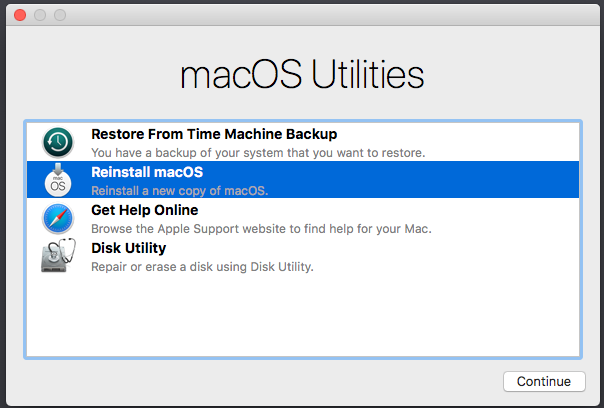- Os High Sierra Recovery Disk Assistant
- Macos High Sierra Recovery Disk Locked
- High Sierra Recovery Disk Assistant
- When you start up a Mac while holding down Command-R on the keyboard, the Mac boots into macOS Recovery. In this mode, you can run Disk Utility, access the command-line Terminal app, and reinstall.
- Note: The 'Startup Disk' of macOS Big Sur (11.0), macOS Catalina (10.15), macOS Mojave (10.14), and macOS 10.13 High Sierra with SSDs (Solid State Drives) cannot be rebuilt with DiskWarrior as they are automatically pre-loaded with Apple File System (APFS).
Os High Sierra Recovery Disk Assistant
Close disk utility; Do Install new Mac OS from USB; When it tries to setup, don't do anything. Just shut down and reboot again to recovery mode using Command + R keys just when u see the Mac apple. Start here if u did not install a fresh. Reboot mac and use Command + R key to enter recovery mode. Disable Daemon, Agent and Phone home. 思い切って記事を参考にHigh Sierraを上記HDDの予備250Gにクリーンインストール、ログイン後のPatch Updaterが何故かもたつきましたが一晩放置で何とか終了したようです。今のところ素のHigh Sierraと対応Onxyのみですが問題なく動作はするのですが. There are also a few changes in macOS High Sierra thanks to the new file format Apple has introduced: APFS (more on that below). Why use Disk Utility You might want to use Disk Utility it if you.

When you start up a Mac while holding down Command-R on the keyboard, the Mac boots into macOS Recovery. In this mode, you can run Disk Utility, access the command-line Terminal app, and reinstall the operating system. But what do you do if you restart your Mac into Recovery mode and a language appears other than one you know?
Macos High Sierra Recovery Disk Locked

High Sierra Recovery Disk Assistant

This doesn't seem to happen at random, but it can occur when you've purchased a computer from someone who installed the system using another language, which can remain in place in the Recovery partition, a separately organized part of your startup drive.

Fortunately, there are a few ways to resolve this.
- Choose the third menu from the left, which is labeled File when in English, and pick the first option, which is labeled Change Language in English. You should be able to select the language you want.
- Launch Terminal, which is in the fifth menu from the left, labeled Utilities in English. The apps have icons next to them, and Terminal is a little rectangle with a prompt in it. After Terminal launches, type
sudo languagesetupand press Return. You can then select the language to use. - If you have a Keyboard menu at the far right of the screen, you can select the one with a tiny U.S. flag to switch to English.
- If all else fails, you can reinstall macOS by restarting your Mac and then holding down Command-Option-R. This will re-download installation files and prompt you for a language choice, while also upgrading the Recovery partition. It won't overwrite your hard drive, but installs in place the latest version of macOS that works on your computer.
This Mac 911 article is in response to a question submitted by Macworld reader Curtis.

When you start up a Mac while holding down Command-R on the keyboard, the Mac boots into macOS Recovery. In this mode, you can run Disk Utility, access the command-line Terminal app, and reinstall the operating system. But what do you do if you restart your Mac into Recovery mode and a language appears other than one you know?
Macos High Sierra Recovery Disk Locked
High Sierra Recovery Disk Assistant
This doesn't seem to happen at random, but it can occur when you've purchased a computer from someone who installed the system using another language, which can remain in place in the Recovery partition, a separately organized part of your startup drive.
Fortunately, there are a few ways to resolve this.
- Choose the third menu from the left, which is labeled File when in English, and pick the first option, which is labeled Change Language in English. You should be able to select the language you want.
- Launch Terminal, which is in the fifth menu from the left, labeled Utilities in English. The apps have icons next to them, and Terminal is a little rectangle with a prompt in it. After Terminal launches, type
sudo languagesetupand press Return. You can then select the language to use. - If you have a Keyboard menu at the far right of the screen, you can select the one with a tiny U.S. flag to switch to English.
- If all else fails, you can reinstall macOS by restarting your Mac and then holding down Command-Option-R. This will re-download installation files and prompt you for a language choice, while also upgrading the Recovery partition. It won't overwrite your hard drive, but installs in place the latest version of macOS that works on your computer.
This Mac 911 article is in response to a question submitted by Macworld reader Curtis.
Ask Mac 911
We've compiled a list of the questions we get asked most frequently along with answers and links to columns: read our super FAQ to see if your question is covered. If not, we're always looking for new problems to solve! Email yours to mac911@macworld.com including screen captures as appropriate, and whether you want your full name used. Every question won't be answered, we don't reply to email, and we cannot provide direct troubleshooting advice.

